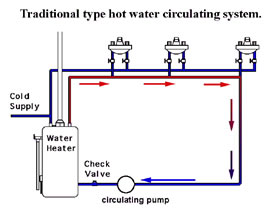Residential & Commercial HVAC-R Installation, Replacement & Repairs

Water Heater Recirculation Pumps

Quick Appliance Service is installing a hot water recirculation pump for use with your water heater will save you time, water, and money. When you don't want to wait for hot water to reach your faucets, a recirculation pump can be a welcome addition.
How do these recirculation pumps work?
The hot water line in your home carries hot water from your hot water heater to the different sinks, baths, and showers in your home. If you turn on your hot water faucet in a house without a recirculation system, all the water sitting in the water line has to pass through the pipes before the hot water from your hot water heater will reach your faucet. The result is gallons of water wasted while waiting for hot water to arrive.
A hot water recirculation system runs a return line from the end of your last faucet back to the water heater, so hot water is available instantly. Instead of wasting water down the drain waiting for hot water, it's already there! This result in saving water, lowers energy costs, and provides the convenience of having hot water instantly.
Main features and benefits for these recirculation pumps:
Gives you instant hot water whenever you turn on your faucet, shower, or tub - don't waste time waiting
A recirculating hot water system saves the average family of four up to 17,000 gallons of water a year - great for the environment, your water bill, and your sewage bill
24 hour timer included - allows you to run the recirculation pump according to your schedule
I'd like to have hot water without much of a wait. How can I do this?
The two easiest solutions are:
A) A thankless water heater at the source.
B) A hot-water recirculation system. This consists of a small pump and a return line from your farthest fixture. The pump mounts near the bottom of your water heater along with a swing check valve.
Does a hot water recirculating system use up a lot of energy?
Both options use energy. But not as much as most people think. On the recirculating system we highly recommend insulating all of your hot water pipes. Also having a timer and/or a thermostat will use even less energy.
Is the thermostat adjustable?
The thermostatic control automatically turns the circulator off when the temperature exceeds approximately 105°F and back on when the temperature drops below approximately 85°F. The thermostat is not adjustable.
Why don't you recommend ordering thermostats with the line cord pumps?
Due to these pumps being pre-wired, they would require re-wiring in order to use the thermostats, so we recommend you purchase the pump, thermostat and timer separately when you want to use a thermostat.
What is the benefit of installing an optional timer or thermostat?
Either one will save energy (and money). The timer only allows the pump to turn on at certain times. So if you only need hot water in the morning, you could set the timer for 6am to 8am. Then the pump would only recirculate the hot water during that time. The thermostat turns off the pump when the water in the pipes reaches a certain temperature. So once the water in the pipe is hot, the pump turns off. When the timer and thermostatic controls are installed together, in series, the circulator operates ONLY at the preset clock times specified by the user and only when the temperature conditions of the thermostat are met. That is, if either the timer control or the thermostatic control switch is open (off), the circulator will not operate.
Typical hot water system before a recirculation pump.
|
Common recirculation pump installation.
 |
Close-Up of pump installation.
|
Several methods have been employed to reduce the energy waste associated with hot water pump circulating systems.
Timers are sometimes placed on the circulating pump so the system shuts the hot water pump off during hours that one normally uses hot water such as from midnight to 6:00 a. m.
Sometimes the circulating pump is controlled by a temperature sensing circuit that shuts the hot water pump off once the water temperature reaches a pre-set temperature such as 40 degrees and then starts the pump back up when the water temperature in the pipe drops below a second set point such as 110 degrees. This type of system does little to reduce the energy losses because the lower set point is still high enough to cause continual large heat losses from the system, and the pump does not contribute nearly as much to the loss as the heat loss itself.

Recirculation Pump: Water Heater Mounted
This type of recirculation pump system consists of a 120 volt pump and timer that is mounted to the water heater hot water line, and a thermostatically controlled bypass valve mounted between the hot and cold water lines at the sink farthest away from the water heater.
At pre-set times on the timer, the recirculation pump turns on and hot water is circulated within the hot water line, making it available for immediate use at the faucet or appliance

Each year, thousands of gallons of wasted water go down the drain in American homes, and with them, thousands of dollars for homeowners, utility companies, and taxpayers. A significant amount of this waste occurs when homeowners wait for their water to reach a comfortable temperature before they shower or wash their hands.
Why do homeowners have to wait for hot water? In a traditional hot water system, water runs from the water heater to each faucet in the home but ends at the farthest faucet, leaving some water in the pipes to cool. When a homeowner turns on a faucet, the cooled water sitting in the pipes circulates to the faucet first, so the homeowner has to wait for hot water.
There's a simple and inexpensive way to eliminate the wait for hot water that will delight our customers and help conserve water. By installing circulation systems in your home, we can give to our customer’s instant hot water at the faucet.
A hot water circulation pump sends cool water in the pipes back to the water heater through a return line. A pump circulates this water through the water heater as needed to keep it hot. This continuous loop of water through the water heater ensures that hot water is always available.
A hot water circulation system includes these features:
- A pump circulates water through the water heater.
- A thermostat controls the temperature in the return line by automatically switching the pump on or off to keep the temperature between 95 and 125 degrees Fahrenheit.
- A timer activates the thermostat to check the temperature at built-in intervals.
- An optional programmable timer allows homeowners to regulate how often the timer and thermostat turn on. Homeowners can activate the pump during periods of high water usage, such as early in the morning when they're getting ready for their workday.
- An isolation valve isolates the pump from the system if the homeowner needs to remove it for cleaning.
- A check valve prevents backflow, a dangerous reversal of water flow that could contaminate the home's plumbing system.




